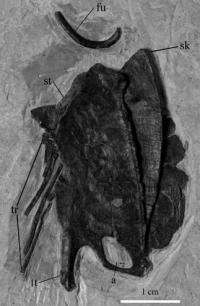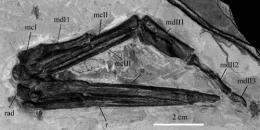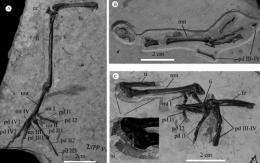Fig.1: Furcula and sternum of Gansus yumenensis (Images by LI Yan)
LI Yan, associate curator of Gansu Museum, collected 9 specimens of Gansus for further study during his fieldwork from 2002 to 2004. He and his collaborators from Institute of Vertebrate Paleontology and Paleoanthropology, Key Laboratory of Evolutionary Systematics of Vertebrates, Chinese Academy of Sciences, described some new anatomical features, as reported in the latest issue of Vertebrata PalAsiatic 2011(4), adding to our understanding of the skeletal anatomy of this basal ornithurine.
Gansus yumenensis is the first Mesozoic bird found in China, originally based only on a unique specimen of the left foot from the Lower Cretaceous (115 to 105 million years ago) Xiagou Formation near Changma, Gansu Province, northwestern China in 1984. Later on, five more well-preserved specimens were found in mudstone at the site of an ancient lake at Changma, Gansu; the geological stratum in which the fossils were found is considered to be equivalent to the Early Cretaceous strata yielding the Jehol biota in western Liaoning. It is recognized as more closely allied to neornithean birds than to Archaeopteryx.
Fig.2: Forelimbs of Gansus yumenensis (Images by LI Yan)
Gansus yumenensis was about the size of a pigeon and similar in appearance to loons and diving ducks. It had many features common among modern birds, and also retained some primitive traits such as its clawed wings.
LI and his collaborators described some newly discovered postcranial material of Gansus yumenensis, and such anatomical features include a laterally exposed sternum with a sickle-shaped keel, the ulnare with small metacarpal incision, complete loss of ungual of the minor digit, and manual phalangeal formula of “2−3−1”, as well as some more detailed features of the leg bones.
“The new material not only provided additional evidence of interdigital web but also preserved some scale-like skin impressions near the joint between the tibiotarsus and tarsometatarsus”, said Dr. ZHOU Zhonghe, co-author, Institute of Vertebrate Paleontology and Paleoanthropology, Chinese Academy of Sciences.
Fig.3: Hindlimbs and skin impression of Gansus yumenensis (Images by LI Yan)
“Based on some characters such as elongated phalanges and short claws with pointed flexor tubercles, Gansus yumenensis is regarded as the bird adapted to life in the aquatic environment. Our statistic analysis of the measurements of the sternum and major elements of the leg of Gansus further supports the hypothesis that this bird was a volant and diving bird, similar to that of extant ducks”, said Dr. ZHANG Yu-Guang, co-author, Key Laboratory of Evolutionary Systematics of Vertebrates, Chinese Academy of Sciences, and Beijing Museum of Natural History.
Provided by Institute of Vertebrate Paleontology and Paleoanthropology

























